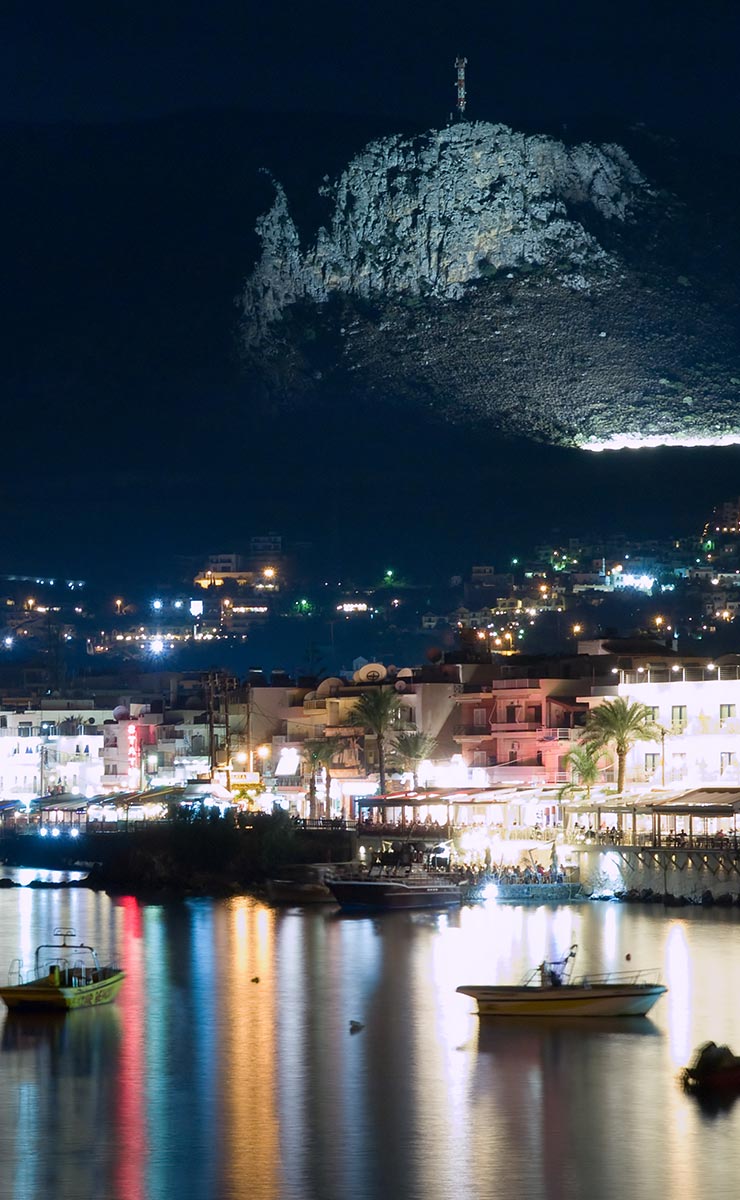Hersonissos (sometimes spelled "Chersonissos") is the name of a town, and a municipality, which lines a stretch of the northern Cretan coastline running NW-SE for about 5 km. The word comes from the Greek for "peninsula," the peninsula in question being a rather small one jutting about 200 meters into the Sea of Crete at the northern end of the harbor of Hersonissos.
Upper Hersonissos, also known as Old Hersonissos, Herson is a village about 3 km inland from the port. Hersonissos is about 25 km east of Heraklion and just west of the busy resort of Malia. Like Malia, Hersonissos is a place of intense partying and playing. Built for the under-30 crowd, Hersonissos nevertheless has some things to offer those of all ages.
History
Hersonissos was originally a settlement during Minoan Crete (2600-1600 BC). Small artifacts have been found in the area, especially on the little peninsula itself, on Kastri Hill, which is sort of a 180 meter-wide knob at the end of the more narrow (60 m wide) peninsula. In the area of the Agia Paraskevi chapel there are remnants of a wall, and of a complex of buildings thought to comprise a sacred acropolis precinct including a temple to Artemis Britomartis, the Minoan version of Artemis, goddess of nature and of the hunt.
After the Minoans were wiped out by the explosion of the volcanic island Santorini 125 km to the north, Hersonissos was quickly resettled, its harbor making it a desirable place for a port. During the Hellenistic period (300 BC) about 30 tombs were cut out of the rock of the peninsula. The cemetery is considered larger but more excavation is no longer possible because foundations of current buildings prevent it. A lot of artifacts were found in the tombs.
Hersonissos was an important port during Roman times, and continued to be so during the Byzantine era, developing an outside water resource with the construction of an aqueduct, which emptied into a reservoir holding 7,000 cubic meters of water. There was also a theatre and a baths complex. As a port it served the inland city of Littos, about 15 km inland and one of Crete's most important settlements at the time.
The theatre was destroyed by fire in the late 1800's, and much of its building material was appropriated by the villagers. As the centuries passed, Upper Hersonissos was founded as a defensive measure against marauding pirates. The village suffered a decline and by the turn of the 20th century had barely 125 residents. The harbor was still being used to ship out agricultural products, however.
Construction on the first hotels and resorts began in the 1960's, and from then on development in the area was rapid and extensive.
Best hotels in Hersonissos
This new luxury five-star resort caters to the most demanding and discerning clientele, offering its unique architectural features, design, premium spa facilities, wide range of VIP services, and the unparalleled beauty of its seaside setting
Nana Golden Beach’s heart is with the family. Recently renovated, this first-class Cretan resort offers a wide range of high-end facilities to satisfy guests at any age
The Grand Hotel Holiday Resort rests in Hersonissos of Crete, 25 kilometers east of Heraklion International Airport in an area well known for its mild climate throughout the year
Things to Do and See: Beaches
On the beaches there are all kinds of things to do. We'll deal with beaches no more than 2 km either up or down the coast from the village of Hersonissos, which makes all of these beaches within relative walking distance. It's good to remember that most of this 5 or 6-km piece of coastline is relatively developed, with lots of shops, restaurants, beach bars, night clubs and the like. If you want to sleep at night, accommodations in Upper Hersonissos (2 km from the beach), or if the neighboring villages of Piskopiano and Koutouloufari (1 km from the beach) might be a better bet, because partying does go on all night long in many places along the seaside.
For the sake of clarity, I'll just say "west" instead of "northwest," which is the actual orientation of the shoreline west of Hersonissos. So starting from the west, about 1.5 km away, and working towards the harbor, there are a number of small, unorganized (no beds or umbrellas) places to swim. Up near the village of Anissaras there is a nudist beach you should be aware of. It's more of a flat rocky shelf than a beach, and it isn't very secluded. Just east of this beach, towards Hersonissos, is a nice little cove framed by 10 meter-high white cliffs, with large, wave-pounded, house-sized boulders set among the sand. There are no amenities, but it's a nice, private place to swim.
Best hotels in Crete
Tailor-made for couples and honeymooners. Water is the over-arching theme of Stella Island, and it has the feel of an ultra-clean, tropical version of Venice
Nana Golden Beach’s heart is with the family. Recently renovated, this first-class Cretan resort offers a wide range of high-end facilities to satisfy guests at any age
Lyttos Mare is a massive, family friendly, 397-room 5-star resort on Crete’s north shore in Hersonissos. Newly opened in 2021, it is an architectural marvel. It’s shaped like a massive letter omega (Ω), with the open end facing the sea
The Limanakia ("Little Harbors") are a series of small coves separated by little headlands. Parking is right on the sea road, with the shore just a few meters away. While these narrow beaches themselves are mostly sandy, there are a lot of large rock formations as well. There are umbrellas and sun beds for rent, with restaurants and lodging nearby.
The town beach, or port beach, is both east and west of the town harbor. The west beach is the longest continuous beach in Hersonissos and begins just west of the peninsula. It stretches west for about 600 meters until the Kreta Maris Hotel. It is very busy during the summer, and can get quite windy. East of the harbor the beach begins about 400m from the peninsula and harbor, and continues for about 500 m.
Star Beach- This is the big one. About 1.5 km east of the harbor, Star Beach is where it all happens at Hersonissos. This sprawling resort, water park and beach attracts thousands daily in high season. Star beach has everything. Want to go horseback riding? Drive a go-cart? Bungee jump off a giant crane into the sea? Cook yourself dark brown on the beach? Swim in the clear aquamarine waters of the Aegean? Paraglide? Jet Ski? Scuba Dive? Rent a banana boat? Tie one on at a beach bar? Party and dance all night as if the world were coming to an end in the morning? Paraglide? Scuba dive? Play on the slides in a water park?
All these and more are available to you at Star Beach. There is the Lazy River, on which you can float while taking a tour of the area. People sunbathe on the grass as well as on the beach, wander around in their bathing suits, eat, drink, and enjoy the sun. A visit to Star Beach is an all-day, nonstop activity kind of event.
There are a number of smaller beaches a bit east of Star Beach, little, rock-bordered coves offering relative quiet and seclusion, but little in the way of organized activities. But sometimes all you need is the sea, some sand, and some sun.
Other Things to do and See
Aquaworld Aquarium, in Hersonissos 300 meters inland from the New York Beach club, just east of the harbor, a natural history museum, was founded in 1995. It's an aquarium and reptile rescue center. It features snakes, lizards, and tortoises which can be safely fed and handled by visitors and children. It is one of only 3 aquariums in Greece. It also displays a variety of local marine life in aquariums. After a one-time fee of €6 for adults and €4 for children, visitors can return as often as they like during the year.
Lychnostatis Open Air Museum is a collection of Cretan folk tradition artifacts originally owned by an ophthalmologist named Yiorgos Markakis. The museum, located near the harbor, purposes to show elements of Cretan folk life, including in its exhibits such objects as wine and olive presses, a distillery, a herb and a cactus garden, fruit orchards, a folk art gallery, weaving and ceramic workshops, an auditorium used for staging performances, and an annual "Traditional September" celebration, featuring dancing performances and wine tasting.
The Black Rose Pirate Boat leaves mid-morning from the harbor daily. This mock up of a pirate ship, an homage to the privateers who used to plague the waters in the area, costs €28 and is an all-day excursion along the caves, inlets, and coast to the village and resort of Sissi, about 12 km east of Hersonissos, where there is a 1-hour stopover. Barbeque lunch is served, and the "pirate" crew and captain, wearing bandannas and striped baggy trousers, are very friendly, especially to kids. If you're lucky the captain will let you steer the boat.
Finally, no trip to Hersonissos would be complete without a day spent absorbing the traditional life of Upper Hersonissos. As in all Greek villages, there is the brick-paved town square, the cafes, the restaurants with their white table cloths and outdoor seating, and a chance to see the more normal daily life of the village. A visit to the local church to admire its Byzantine-style icons and other artwork and contemplate in its quiet interior is also a rewarding experience. There are also plenty of places to stay in the upper village, which, as has been mentioned, is a much quieter place than the sometimes chaotic beachfront.

















